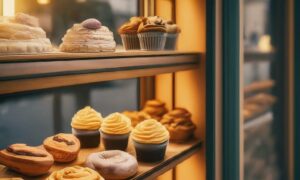
Learn how to fix macaron batter that’s too thick with this comprehensive step-by-step guide. Discover the ideal macaron batter consistency, common causes of thick batter, and effective solutions to achieve perfect macarons.
Welcome to the world of macaron baking, where creativity meets precision to create these delightful and delicate French treats. As a macaron enthusiast, you might have encountered the frustration of dealing with thick macaron batter, which can jeopardize the perfect texture and appearance of these exquisite cookies. But worry not! In this article, we will explore the ideal macaron batter consistency, the common causes of thick batter, and most importantly, provide you with a comprehensive step-by-step guide to fix macaron batter that’s too thick. Get ready to master the art of macaron baking and achieve the perfect macarons you’ve always dreamed of!
Understanding the Ideal Macaron Batter Consistency
Before we dive into fixing thick macaron batter, it’s essential to grasp the concept of the ideal macaron batter consistency. Macaron batter should have a smooth and flowing consistency, often described as “lava-like.” When piped onto a baking sheet, it should spread slightly and form a smooth, glossy surface. Achieving this consistency is crucial for obtaining the characteristic “feet” and smooth tops of macarons.
Common Causes of Thick Macaron Batter
Understanding the reasons behind thick macaron batter will help you address the issue more effectively. Some common causes include:
- Overmixing: Overmixing the batter can lead to excessive incorporation of air, resulting in a thick consistency.
- Incorrect Ingredient Ratios: Incorrect measurements of ingredients, especially the dry ones, can affect the overall consistency of the batter.
- Humidity: High humidity levels in the environment can cause the batter to absorb moisture, making it thicker than desired.
- Egg White Aged Too Long: Using aged egg whites beyond their optimal period can lead to a thicker batter.
Step-by-step Guide to Fixing Thick Macaron Batter
Now that we know the causes, let’s dive into the step-by-step guide to fix thick macaron batter. We’ll explore various methods to adjust the consistency and achieve the perfect macaron batter.
A. Adjusting Ingredients
- Re-measure Dry Ingredients: Double-check the measurements of dry ingredients, including almond flour and confectioners’ sugar. Use a scale for accuracy.
- Add More Egg Whites: If your batter is too thick, consider adding a small amount of fresh egg whites (unbeaten) to the mixture. Gradually fold them in until you reach the desired consistency.
B. Incorporating Additional Liquid
- Use the “Macaronage” Technique: Incorporate the dry ingredients into the beaten egg whites using the “macaronage” technique. This involves folding the mixture gently and repeatedly until it flows like lava.
- Add Flavoring Extracts: If your recipe allows for it, consider incorporating flavoring extracts, such as vanilla or almond, to add a touch of moisture and adjust the batter consistency.
C. Proper Mixing Techniques
- Avoid Overmixing: Mix the batter just until all ingredients are combined. Overmixing can lead to a thick batter, so stop once it reaches a smooth and flowing consistency.
- Test the Ribbon Stage: To determine if your batter is at the right consistency, perform the “ribbon test.” Lift the spatula, and the batter should fall off in a continuous ribbon that slowly blends back into the rest of the batter.
Resting and Testing the Batter
- Rest the Batter: After achieving the desired consistency, let the batter rest for about 15-30 minutes. This allows the dry ingredients to fully hydrate and contributes to the smoothness of the macarons’ surface.
- Test the Piping: Test the batter by piping a small sample onto a baking sheet. It should spread slightly but still hold its shape. If it spreads excessively, it might be too thin, and you should adjust accordingly.
Preventative Measures for Future Batches
- Keep Track of Ingredients: Maintain a record of the ingredients and measurements used in successful batches to replicate them accurately.
- Control Humidity: If humidity is a recurring issue, consider using a dehumidifier or air conditioner in your kitchen while baking macarons.
- Use Fresh Egg Whites: Aim to use egg whites that are between 1-5 days old for the best consistency and results.
Troubleshooting Other Macaron Issues
- Hollow Shells: Hollow macarons might be caused by overmixing or inadequate resting. Adjust your technique accordingly.
- Cracked Shells: Cracked macarons could result from excessive air in the batter or abrupt temperature changes during baking.
- No Feet: If your macarons lack the characteristic “feet,” the batter might have been too thick or not allowed to rest adequately.
How do you fix too thick macaron batter?
Fixing too thick macaron batter involves adjusting the consistency to achieve the ideal “lava-like” texture. There are several methods to fix it:
- Adjusting Ingredients: Double-check the measurements of dry ingredients and consider adding a small amount of fresh egg whites (unbeaten) to the mixture until it reaches the desired consistency.
- Incorporating Additional Liquid: Use the “macaronage” technique to fold the dry ingredients into the beaten egg whites gently. You can also add flavoring extracts to add moisture and adjust the batter consistency.
Can you fix macaron batter?
Yes, you can fix macaron batter that’s too thick or too thin. By following the step-by-step guide and using the proper techniques, you can adjust the consistency to achieve the ideal texture for perfect macarons.
Is macaron batter supposed to be thick?
No, macaron batter is not supposed to be thick. The ideal macaron batter consistency is smooth and flowing, often described as “lava-like.” It should spread slightly and form a smooth, glossy surface when piped onto a baking sheet.
What happens if you over-fold macaron batter?
Over-folding macaron batter can lead to several issues. It can incorporate excessive air into the batter, resulting in a thick and inflated consistency. This can lead to cracked shells and uneven feet during baking. It’s crucial to stop mixing the batter once it reaches a smooth and flowing consistency to avoid over-folding.
Macaron Recipe: 7 Easy And Elegant Tasty Macarons
Conclusion:
Congratulations! You’ve now learned the secrets to fix macaron batter that’s too thick and discovered valuable tips for achieving the ideal macaron consistency. With the right techniques and a bit of practice, you’ll soon become a macaron-baking pro. Remember to pay attention to ingredient measurements, avoid overmixing, and control humidity levels to master the art of making picture-perfect macarons every time.
FAQs
Macaron Batter Too Thick: How to Fix
If your macaron batter is too thick, don’t worry; there are ways to fix it and achieve the perfect consistency. Here’s what you can do:
- Adjust Dry Ingredients: Double-check the measurements of almond flour and confectioners’ sugar. If they are slightly off, add a bit more of the appropriate ingredient to balance the consistency.
- Incorporate More Egg Whites: Gradually add a small amount of fresh egg whites (unbeaten) to the batter and gently fold them in. This will help loosen the thick batter.
- Use the “Macaronage” Technique: Continue folding the batter using the “macaronage” technique until it flows like lava. Be gentle and patient to achieve the desired smoothness.
How to Fix Grainy Macaron Batter
Grainy macaron batter can lead to undesirable texture in your final product. Here’s how to fix it:
- Sift Dry Ingredients: Sift the almond flour and confectioners’ sugar to remove any lumps and achieve a finer texture.
- Pulse in a Food Processor: If the almond flour is grainy, pulse it in a food processor to make it smoother before incorporating it into the egg whites.
- Mix Thoroughly: Ensure that all ingredients are well combined during the macaronage process to eliminate any graininess.
Why is My Macaron Batter Sticky
Sticky macaron batter can be problematic during the piping process. Here are some reasons why it might be sticky:
- High Humidity: Macaron batter can become sticky in humid conditions. Consider using a dehumidifier in your kitchen while baking.
- Overbeating Egg Whites: Overbeating the egg whites can lead to a sticky batter. Stop beating once stiff peaks form.
Why is My Macaron Batter Grainy
A grainy macaron batter can result in uneven texture and appearance. The following factors might cause graininess:
- Untreated Almond Flour: If the almond flour is not processed finely enough, it can cause graininess. Always use finely ground almond flour.
- Insufficient Mixing: Properly mix the ingredients during the macaronage process to avoid grainy batter.
Macaron Batter Consistency
The ideal macaron batter consistency is smooth and flowing, resembling lava. It should spread slightly when piped onto a baking sheet, forming a smooth and glossy surface.
Can You Add Milk to Macaron Batter
No, you should not add milk to macaron batter. Traditional macaron recipes do not include milk as an ingredient. Adding milk can significantly alter the batter’s consistency and result in a different texture.
Can You Add Water to Macaron Batter
No, water should not be added to macaron batter. Water can negatively impact the batter’s consistency and might lead to undesirable results during baking. Stick to the traditional macaron recipe for the best outcomes.






